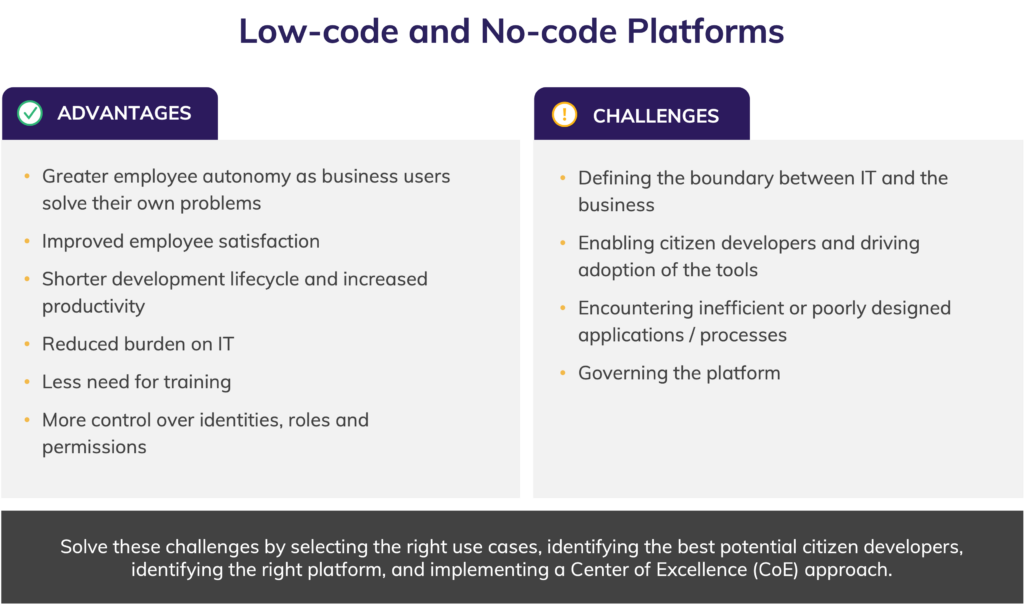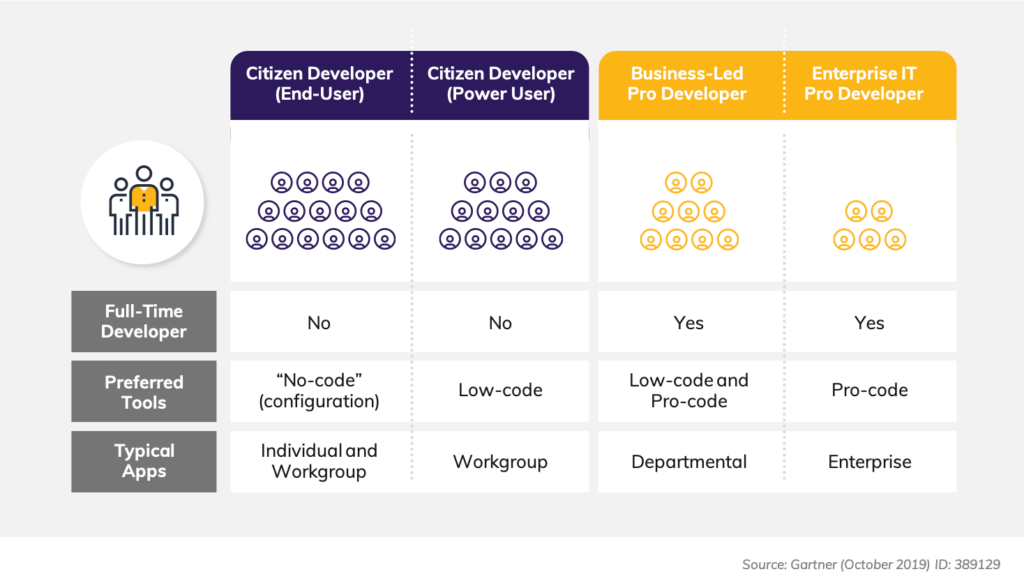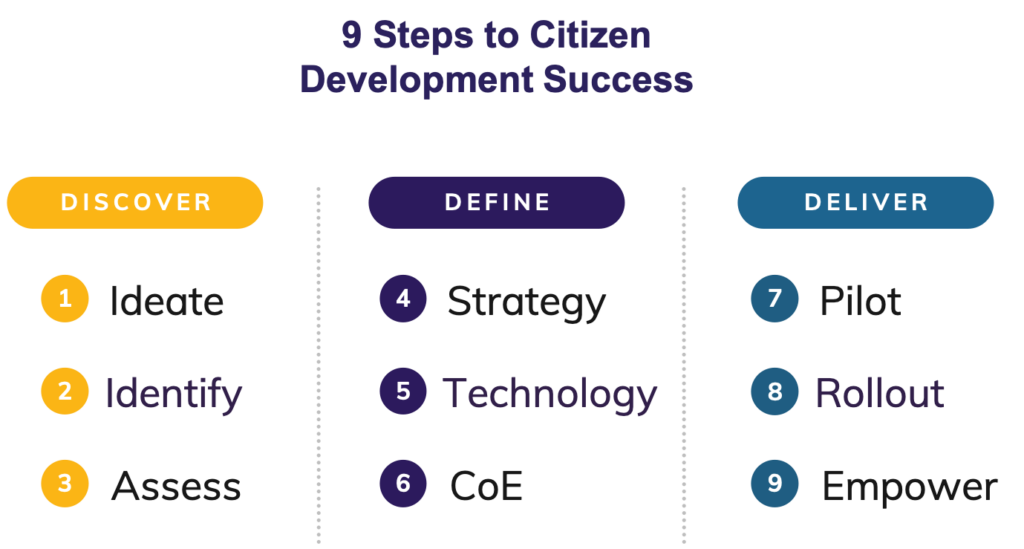Today’s employees can order lunch from their phone and have it delivered to their desk in 30 minutes. Why can’t their work be that easy? With citizen development, it can be.
Citizen developers are simply non-IT employees who see opportunities for using technology to make their work easier and more efficient. They use cloud-based, no-code or low-code platforms to create programs using intuitive interfaces and a mouse instead of strings of code.
Of course, non-IT employees have been automating business processes with macros, spreadsheets, electronic forms and more for years. Many times, they succeeded in relieving their IT colleagues’ workloads. Other times, they created more headaches than solutions.
But now, new tools — including Microsoft’s Power Platform — make it easier not only for citizen developers to make work easier for everyone, but to do so safely.
On this page, we provide some background on the citizen development movement, and we explain how to use a Center of Excellence (CoE) approach to reduce risk and earn a return on your investment in citizen development.
Chapters
Why Do You Need Citizen Development Now?
What’s Powering Citizen Development?
What Are the Best Citizen Development Use Cases?
How Do I Identify Citizen Developers in My Organization?
How Do I Select a Citizen Development Platform?
How Do I Operationalize Citizen Development?
What Should I Be Watching Out For?
Sustaining Your Citizen Development Program With a Center of Excellence
Conclusion
Why Do You Need Citizen Development Now?
Today, both consumers and employees demand more digital interactions.
Consumers are accustomed to getting what they need seamlessly from smartphone apps or traditional websites. Forrester projects online retail sales in the U.S. alone will top $1.6 Trillion by 2027.
Meanwhile, employees are also consumers. They use technology every day to make their personal lives easier — like ordering lunch online! So when they get to work, they expect to complete routine tasks like assembling a simple executive key performance indicator (KPI) update as quickly as they can buy a meal.
When employees feel they cannot manage their work lives as easily as their personal lives, they become frustrated. For years, creative non-IT employees have alleviated their frustration by using macros, electronic forms and more to make their daily work easier, often without the blessing or involvement of IT.
Sometimes these efforts have worked well, but often their efforts have caused additional burden for IT by putting systems at risk or creating “shadow IT” organizations.
Fortunately, modern citizen development platforms allow non-IT employees to become official citizen developers, fully endorsed by your organization and working in partnership with, not against, IT. More importantly, the platforms allow citizen developers to safely improve business processes while delivering the metrics you need to run your business.
With an effective citizen development program in place, you will have happier employees and more efficient operations by allowing IT to focus on more critical needs.
What’s Powering Citizen Development?
Low-code and no-code software platforms are the engine of the citizen development movement. They allow non-IT users to develop applications more easily with development tools designed for business experts, not application development and delivery pros. These user-friendly tools include drag-and-drop design, Excel-like interfaces and application templates that define forms, logic, data and integration.
Of course, using pre-built code components has both advantages and challenges, but overcoming the challenges helps you maximize the advantages.

Advantages of Low-Code and No-Code Citizen Development Platforms
Low-code and no-code platforms empower team members to solve their own problems, providing greater autonomy and improving employee satisfaction. Satisfaction levels will continue to rise among all employees as tools become easier to use, development lifecycles decrease and productivity increases.
Meanwhile, low-code and no-code solutions will reduce the day-to-day burden on IT. With business users creating the apps they need to perform their work, IT staff can tackle the larger problems you hired them to address.
In addition, most vendors provide simple, cost-effective access to their platforms for tryouts and ongoing work, while providing help and support to eliminate the need for customer training. As a result, citizen developers can build and deploy all apps on managed platforms, which creates opportunities for IT to influence, support and control their efforts without being overwhelmed.
The leading platforms also offer a variety of tools and control to help set up identities, roles and permissions, often delivering guardrails to speed up application development, administer platform operations, and troubleshoot performance and reliability problems.
The result is fast, novel solutions generated by the people who need them most — the team members close to the business who rely on these solutions to solve every day business challenges.
Challenges of Low-Code and No-Code Citizen Development Platforms
Every challenge low-code and no-code platforms present not only has a solution, but each solution strengthens the benefits the platforms deliver.
For example, better defining the boundaries between IT and the business will improve all your development efforts, whether related to citizen development or not. As you further enable citizen developers and drive adoption, development lifecycles will continue to tighten and productivity will continue to rise. Meanwhile, as citizen developers encounter and solve inefficiencies or poor designs, they will become even more autonomous and satisfied with their work.
Citizen development challenges can be solved by:
- Selecting the right use cases
- Identifying the best potential citizen developers
- Identifying the right platform
- Implementing a Center of Excellence (CoE) approach to establish a framework for success.
What Are the Best Citizen Development Use Cases?
In general, the best citizen development projects involve automation. They follow our three Rs of automation — routine, repeatable and rules-based. You are looking for simple, objective tasks that are low-cost but deliver valuable solutions quickly.
In order of increasing complexity, you can categorize these projects as:
- Task Automation: Notifications, approvals, smart forms. These citizen development initiatives may support key groups such as HR, IT help desk or facilities management.
- Workflow Automation: End-to-end processes that connect multiple systems or data sets and may include some human interaction. For example, citizen developers can improve business processes and workflows within apps or provide better or cohesive user interfaces for existing apps.
- Reasoning Automation: Intelligent processing, machine learning, chatbots, data analytics. Activities such as order tracking, inventory, reporting analysis, contact management or data integration may benefit from these solutions.
No matter the use case, a well-thought-out and implemented citizen development project will speed processes and free up IT resources. At the same time, it will increase speed and accuracy while decreasing dependence on e-mail and files.
However, using citizen development for the wrong types of projects can lead to problems. You should not use citizen development for your most strategic, critical business applications, such as ERP, supply chain or foundational client applications. After all, you wouldn’t order a five-course French meal over an app, would you?
But choosing the right projects is only half the battle. You also must be sure you choose the right type of employees to be part of your citizen development team.
How Do I Identify Citizen Developers in My Organization?
By definition, citizen developers are employees who are not part of IT. While they may have some experience in programming, writing code is not their full-time role. Instead, they are experts in their areas of the organization. Their business knowledge is the value they bring to their applications, as long as they can build those apps within IT’s development guidelines.
Qualities Good Citizen Developers Share
Generally, good citizen developers have a passion for solving business problems and a keen understanding of what the business needs. They are the employees whom others go to with questions about business applications. They know how to optimize apps for specific tasks and enjoy exploring the use of technology to make work more efficient.
They also must have an eye for processes they can improve through automation, RPA or even hyperautomation – the combination of RPA and machine learning. Job titles in your organization that may yield citizen developers include:
- Application administrator
- User support
- Business analyst
- User experience designer
- Front-end web designer
- Business intelligence specialist.
Don’t Leave Out IT
Citizen developers are not the only people you need to have on your mind. IT staff are a critical part of any citizen development program. Look at your current IT staff to identify potential leaders. They should be practical-minded people with a solid understanding of the risks that might emerge as your citizen development program ramps up. And of course, you must consider their bandwidth given their day-to-day responsibilities.
How Do I Select a Platform?
Many sources provide information on the various low-code and no-code citizen development platforms, but knowing the functions won’t help if you haven’t first identified your needs. Work with your team to create a rubric to help with the selection process. Some basic questions your rubric should address include:
- Do the tools need to work on mobile devices?
- How friendly does the user experience need to be? How flexible are the app design capabilities?
- What are my data design, data interactions and data source requirements? Do I need a tool with a database?
- Am I interested in exploring the use of artificial intelligence (AI) now or in the future?
- How much and what kind of support am I likely to need from the platform vendor?
- What key architecture components do I need to enable citizen development projects to work safely with my larger enterprise apps?
- What are my availability and scalability requirements? Do I need multi-region support?
- How are my workflows orchestrated, and will the platform support them?
Beyond these basic questions are larger issues of licensing costs, security and governance. We will explore these topics in more detail in our next three sections.
How Do I Operationalize Citizen Development?
With your crew of citizen developers identified, use cases selected and tools installed, your teams will be eager to get started. However, as with any change that affects people and processes, it is best to start slowly.
Look for smaller pilot projects your teams urgently need and can develop quickly. Delivering quick wins will drive involvement and speed adoption. You can build up to more complex projects as your citizen development program matures.
As you get started, we recommend a nine-step program to operationalize your citizen development initiative. You can group these steps into three phases: Discover, Define and Deliver.
Discover
- Ideate: Your citizen development journey begins with a vision. Begin by talking with employees about their pain points and talk with your fellow leaders about different types of citizen development platforms. Include discussions of risk, both for technology and for processes. Can you draw on lessons learned from smaller-scale projects?
- Identify: You must not only identify employees who will be good citizen developers but also the existing tools, systems and data sources that are available to them. You probably have some citizen development tools in your organization already — you just haven’t thought of them as such. Document your technology and people requirements, as well as your IT backlog.
- Assess: Consider both the business and IT sides of your citizen development program. Include not only personnel but also the types of solutions your company has tried in the past. What has been successful or unsuccessful?
Define
- Strategy: Clearly articulate your vision and objectives. What are you trying to achieve, and why? Communicate what types of apps you and your team will develop, how you will deploy these, the citizen developers’ role, and the departments affected.
- Technology: In addition to selecting the platform itself, consider who will own its architecture. Will you roll existing tools into the platform or discontinue these? Also, make sure training is in place not only for citizen developers but for administrators and IT support, as well.
- Center of Excellence (CoE): A CoE approach to citizen development allows you to deliver enterprise automation, but it enables more than rapid software delivery. It also provides a governance framework for your people, processes, technology and metrics. We explore the CoE more later.
Deliver
- Pilot: After selecting a manageable pilot project, identify and communicate its criteria for success. The pilot is about more than testing technology. It also must communicate training, rollout plans and expectations.
- Rollout: Once you verify your infrastructure and governance are in place, begin rolling out the functionality proven by the pilot. Be prepared for a high level of training and support early on, and encourage employees to stick with it through branding, internal marketing or incentives.
- Empower: As your rollout continues, create a culture of continuous learning by identifying online resources for further training, encouraging citizen developers to pursue certifications, and identifying citizen development champions in your organization for training and guidance. Share news of success often through newsletters, regular updates and activity dashboards.
What Should I Be Watching Out For?
Citizen development’s goal is to roll out better solutions more quickly, not to create more problems. Unfortunately, employees’ past experiences with “shadow IT” groups within your organization may make them skeptical of your citizen development initiative.
That’s why it’s important to communicate how citizen development differs from “shadow IT.” Citizen developers work under an established governance framework. While they will have ideas of the types of projects to pursue, the final decision is not left entirely to them. Their role is to work with IT, not behind their backs — the way a good sous chef partners with the head chef.
You must also communicate your citizen development vision to all employees, especially IT. Officially engage IT from the beginning, and define clear roles for employees who will work with citizen developers.
Other areas to monitor carefully include:
- Security and data leakage: Ensure you restrict access to data to only those who should see it while developing and consuming the app.
- Impact on line-of-business systems: Are citizen development projects bringing your ERP to a crawl, or is it having other negative impacts on critical systems?
- Licensing: Are you experiencing unexpectedly high licensing costs because of how citizen developers built solutions?
- Strategy: Is your strategy preventing you from deploying tools, or are you abandoning tools?
With these critical areas in mind, let’s look more closely at one of the most successful models for sustaining your citizen development initiative, the CoE.
Sustaining Your Citizen Developer Program With a Center of Excellence
A citizen development CoE is a command and control center for your initiative. It provides the network of people and tools needed to oversee the technology, processes and metrics that will help your citizen developers thrive.

People
While you may naturally think about technology first, your people are the ones who determine if your program succeeds or fails.
Start by building a community of practice for your citizen development team and establish policies and governance for it. Your policies should make it clear your IT professionals are participants in the program, just like the citizen developers. Identify champions within IT to guide adoption and change as they serve as liaisons between citizen developers, the business and IT teams. IT is there to give guidance on the tools, ensure security is in place, enforce and communicate safe zones, provide training and more.
In addition to IT champions, other IT employees may be product owners, user experience designers, architects or application development managers. Within the citizen development ranks, you may have administrators, power users, business owners or operators.
All of these people need to engage within the community of practice through tools such as activity dashboards, as well as trainings and activities to build team cohesion and excitement. Together, your citizen development program should combine data and process knowledge from the business with IT’s expertise in the platform, security and compliance.
Processes
The CoE can serve as the clearinghouse for all citizen development projects. The CoE is also responsible for putting governance in place to guide solutions as your team deploys and maintains them.
Your governance documents should include your business’s security and compliance requirements, as well as IT’s role. Some organizations may take a lighter approach to IT, while others may want IT to review all security, deployment, data management and quality control. IT may also be involved in overseeing more sensitive data, solution review and approval, complex integrations or scalability.
Whatever the role you decide is right for IT in your citizen development initiative, make sure you document and communicate it clearly to the entire CoE.
Technology
When you select your platform and put it in place, the CoE administers it. This includes governance responsibilities such as making sure you have security, compliance and data access policies in place, and people follow these. The CoE should also understand the platform’s licensing to avoid unexpected costs as usage ramps up.
Metrics
The CoE should gather data to evaluate the organization’s return on investment for its citizen development program and areas of greater opportunity. The CoE provides a centralized place for all reporting about how the platform is functioning as well as business unit and department-level data.
Conclusion
Citizen development is our future. According to Gartner, “By 2023, the number of active citizen developers at large enterprises will be at least four times the number of professional developers.”
Now is the time to get on board. It may not be an easy journey, but the benefits will be worth it. Start small, put a CoE in place, and give citizen developers and IT employees the tools they need to work together. When your citizen development program is established correctly, you can make working in your organization as easy as ordering lunch for your team!
[On-Demand Webinar] Microsoft Teams and SharePoint: Good Governance Improves Adoption and ROI
Gain an understanding of how Orchestry can be easily implemented and how it helps with new Teams and SharePoint deployments.


